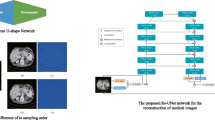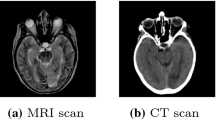Abstract
Computed tomography (CT) image can be reconstructed by various types of kernels depending on what anatomical structure is evaluated. Also, even if the same anatomical structure is analyzed, the kernel being used differs depending on whether it is qualitative or quantitative evaluation. Thus, CT images reconstructed with different kernels would be necessary for accurate diagnosis. However, once CT image is reconstructed with a specific kernel, the CT raw data, sinogram is usually removed because of its large capacity and limited storage. To solve this problem, many methods have been proposed by using deep learning approach using generative adversarial networks in image-to-image translation for kernel conversion. Nevertheless, it is still challenging task that translated image should maintain the anatomical structure of source image in medical domain. In this study, we propose CT kernel conversion method using multi-domain image-to-image translation with generator-guided contrastive learning. Our proposed method maintains the anatomical structure of the source image accurately and can be easily utilized into other multi-domain image-to-image translation methods with only changing the discriminator architecture and without adding any additional networks. Experimental results show that our proposed method can translate CT images from sharp into soft kernels and from soft into sharp kernels compared to other image-to-image translation methods. Our code is available at https://github.com/cychoi97/GGCL.
C. Choi and J. Jeong—Contributed equally.
Access this chapter
Tax calculation will be finalised at checkout
Purchases are for personal use only
Similar content being viewed by others
References
Mackin, D., et al.: Matching and homogenizing convolution kernels for quantitative studies in computed tomography. Invest. Radiol. 54(5), 288 (2019)
Lee, S.M., et al.: CT image conversion among different reconstruction kernels without a sinogram by using a convolutional neural network. Korean J. Radiol. 20(2), 295–303 (2019)
Eun, D.-I., et al.: CT kernel conversions using convolutional neural net for super-resolution with simplified squeeze-and-excitation blocks and progressive learning among smooth and sharp kernels. Comput. Meth. Programs Biomed. 196, 105615 (2020)
Gravina, M., et al.: Leveraging CycleGAN in Lung CT Sinogram-free Kernel Conversion. In: Sclaroff, S., Distante, C., Leo, M., Farinella, G.M., Tombari, F. (eds.) Image Analysis and Processing – ICIAP 2022: 21st International Conference, Lecce, Italy, May 23–27, 2022, Proceedings, Part I, pp. 100–110. Springer International Publishing, Cham (2022). https://doi.org/10.1007/978-3-031-06427-2_9
Yang, S., Kim, E.Y., Ye, J.C.: Continuous conversion of CT kernel using switchable CycleGAN with AdaIN. IEEE Trans. Med. Imaging 40(11), 3015–3029 (2021)
Choi, Y., et al.: Stargan: Unified generative adversarial networks for multi-domain image-to-image translation. In: Proceedings of the IEEE Conference on Computer Vision and Pattern Recognition (2018)
He, Z., et al.: Attgan: facial attribute editing by only changing what you want. IEEE Trans. Image Process. 28(11), 5464–5478 (2019)
Isola, P., et al.: Image-to-image translation with conditional adversarial networks. In: Proceedings of the IEEE Conference on Computer Vision and Pattern Recognition (2017)
Kong, L., et al.: Breaking the dilemma of medical image-to-image translation. Adv. Neural. Inf. Process. Syst. 34, 1964–1978 (2021)
Liu, M.-Y., Breuel, T., Kautz, J.: Unsupervised image-to-image translation networks. Adv. Neural Inform. Process. Syst. 30 (2017)
Pang, Y., et al.: Image-to-image translation: methods and applications. IEEE Trans. Multimedia 24, 3859–3881 (2021)
Park, T., et al. (eds.): Computer Vision – ECCV 2020: 16th European Conference, Glasgow, UK, August 23–28, 2020, Proceedings, Part IX, pp. 319–345. Springer International Publishing, Cham (2020). https://doi.org/10.1007/978-3-030-58545-7_19
Zhu, J.-Y., et al.: Unpaired image-to-image translation using cycle-consistent adversarial networks. In: Proceedings of the IEEE International Conference on Computer Vision (2017)
Goodfellow, I., et al.: Generative adversarial networks. Commun. ACM 63(11), 139–144 (2020)
Huang, X., Belongie, S.: Arbitrary style transfer in real-time with adaptive instance normalization. In: Proceedings of the IEEE International Conference on Computer Vision (2017)
Lee, G., et al.: Generator knows what discriminator should learn in unconditional GANs. In: Avidan, Shai, Brostow, G., Cissé, M., Farinella, G.M., Hassner, T. (eds.) Computer Vision – ECCV 2022: 17th European Conference, Tel Aviv, Israel, October 23–27, 2022, Proceedings, Part XVII, pp. 406–422. Springer Nature Switzerland, Cham (2022). https://doi.org/10.1007/978-3-031-19790-1_25
Mirza, M., Osindero, S.: Conditional generative adversarial nets. arXiv preprint arXiv:1411.1784 (2014)
Park, T., et al.: Semantic image synthesis with spatially-adaptive normalization. In: Proceedings of the IEEE/CVF Conference on Computer Vision and Pattern Recognition (2019)
Sushko, V., et al.: You only need adversarial supervision for semantic image synthesis. arXiv preprint arXiv:2012.04781 (2020)
Wang, X., et al.: Dense contrastive learning for self-supervised visual pre-training. In: Proceedings of the IEEE/CVF Conference on Computer Vision and Pattern Recognition (2021)
Xie, Z., et al.: Propagate yourself: exploring pixel-level consistency for unsupervised visual representation learning. In: Proceedings of the IEEE/CVF Conference on Computer Vision and Pattern Recognition (2021)
Zhang, Y., Yang, Q.: A survey on multi-task learning. IEEE Trans. Knowl. Data Eng. 34(12), 5586–5609 (2021)
Kingma, D.P, Ba, J.: Adam: a method for stochastic optimization. arXiv preprint arXiv:1412.6980 (2014)
Gulrajani, I., et al.: Improved training of wasserstein gans. Adv. Neural Inform. Process. Syst. 30 (2017)
Fardo, F.A., et al.: A formal evaluation of PSNR as quality measurement parameter for image segmentation algorithms. arXiv preprint arXiv:1605.07116 (2016)
Wang, Z., et al.: Image quality assessment: from error visibility to structural similarity. IEEE Trans. Image Process. 13(4), 600–612 (2004)
Odena, A., Dumoulin, V., Olah, C.: Deconvolution and checkerboard artifacts. Distill. 1(10), e3 (2016)
Shi, W., et al.: Real-time single image and video super-resolution using an efficient sub-pixel convolutional neural network. In: Proceedings of the IEEE Conference on Computer Vision and Pattern Recognition (2016)
Ronneberger, O., Fischer, P., Brox, T.: U-net: convolutional networks for biomedical image segmentation. In: Medical Image Computing and Computer-Assisted Intervention–MICCAI 2015: 18th International Conference, Munich, Germany, October 5–9, 2015, Proceedings, Part III 18. Springer (2015)
Miyato, T., et al.: Spectral normalization for generative adversarial networks. arXiv preprint arXiv:1802.05957 (2018)
Acknowledgement
This work was supported by a grant of the Korea Health Technology R&D Project through the Korea Health Industry Development Institute (KHIDI), funded by the Ministry of Health & Welfare, Republic of Korea (HI18C0022) and by Institute of Information & communications Technology Planning & Evaluation (IITP) grant funded by the Korea government (1711134538, 20210003930012002).
Author information
Authors and Affiliations
Corresponding author
Editor information
Editors and Affiliations
1 Electronic supplementary material
Below is the link to the electronic supplementary material.
Rights and permissions
Copyright information
© 2023 The Author(s), under exclusive license to Springer Nature Switzerland AG
About this paper
Cite this paper
Choi, C., Jeong, J., Lee, S., Lee, S.M., Kim, N. (2023). CT Kernel Conversion Using Multi-domain Image-to-Image Translation with Generator-Guided Contrastive Learning. In: Greenspan, H., et al. Medical Image Computing and Computer Assisted Intervention – MICCAI 2023. MICCAI 2023. Lecture Notes in Computer Science, vol 14229. Springer, Cham. https://doi.org/10.1007/978-3-031-43999-5_33
Download citation
DOI: https://doi.org/10.1007/978-3-031-43999-5_33
Published:
Publisher Name: Springer, Cham
Print ISBN: 978-3-031-43998-8
Online ISBN: 978-3-031-43999-5
eBook Packages: Computer ScienceComputer Science (R0)





